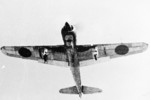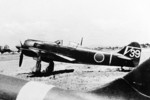Ki-100
| Country | Japan |
| Manufacturer | Kawasaki Aircraft Industries |
| Primary Role | Fighter |
| Maiden Flight | 1 February 1945 |
Contributor: Alan Chanter
ww2dbaseIn May 1945 American aircraft operating over the Japanese home islands began to encounter an exceptionally potent interceptor fighter which appeared in none of the Allied recognition manuals. When the Akashi factory in Hyogo Prefecture, where the unreliable Kawasaki Ha-140 inverted vee piston engine was made, was destroyed during an air raid, Kawasaki was left with 275 completed Ki-61-II airframes without any alternative powerplant. In an inspired piece of improvisation, Kawasaki's Kakamigahara factory in Gifu Prefecture decided to combine these airframe with the 1,500-horsepower Mitsubishi Ha-112-II air-cooled radial engine which had already acquired an excellent reputation for reliability. Amazingly, the conversion was accomplished in less than 12 weeks. Although the Mitsubishi engine was wider and bulkier than the Ha-140, a remarkably neat installation was devised to combine the radial engine with the narrower fuselage, and the first of three converted Ki-61-II Kai, re-designated as Ki-100, flew in prototype form on 1 February 1945. To the amazement of the Japanese design team headed by Takeo Doi this improvised aircraft quickly revealed that the engine's lower weight actually reduced wing and power loadings, providing much improved handling characteristics with only slightly reduced performance. There followed a production run using both the existing airframes and new-build aircraft.
ww2dbaseThe design entered service with the Japanese Army Air Service in March 1945 as the Army Type 5 Fighter Model I-Ko; within Kawasaki, it was known as the Ki-100 fighter. It turned out be an extremely potent interceptor fighter, regarded by some as Japan's outstanding fighter aircraft of the Pacific war. It processed a definite ascendancy over the Grumman F-6F Hellcat fighter (which by then flew in Japanese skies) and was even the equal of the formidable P-51D Mustang fighter. Produced in two sub-variants; the Type 5 Mark I-Ko was the initial model converted from the Ki-61-II Kai airframes, while the Ki-100-I-Otsu employed the airframe that had been intended for the Ki-61-III, with a cut-down rear fuselage and an all-round vision canopy to improve pilot's visibility. In both versions the armament consisted of two fuselage mounted 12.7-millimeter machine guns and two wing-mounted 20-millimeter cannon.
ww2dbaseEighty-eight newly built Ki-100 fighters had left the Kakamigahara plant by 23 July 1945 when deliveries were seriously disrupted by aerial attacks on the assembly plants, and only 378 Ki-100 fighters of both versions would be completed at Kakamigahara when production terminated on 10 August 1945. An additional twelve machines were produced at Ichinomiya in Aichi Prefecture. The Ki-100 fighters were primarily assigned for the defence of the home islands, operating from Chofu in Tokyo and Yokkaichi in Mie Prefecture from the spring of 1945, and serving primarily with the 5th, 17th, 111th and 244th Sentai.
ww2dbaseIn March 1945, an attempt to improve the high-altitude performance resulted in the development of a Ki-100-II variant powered by the Mitsubishi Ha-112-Iru engine, incorporating an Ru-102 turbo-supercharger placed below the engine which displaced some of the fuel system components, but space limitations prohibited the installation of an aftercooler and its associated ducting, and so air had to be ducted directly from the compressor to the carburettor. A methanol water injection system to boost output for short bursts was also fitted. The lack of an intercooler limited the high-altitude performance and the turbo-supercharger added 600 pounds to the plane's weight, thereby reducing maximum speed by approximately 15 miles per hour at 10,000 feet. Nonetheless, the boosting system gave the Ki-100-II a 30 miles per hour speed advantage over the other models at 30,000 feet Only three prototypes of the Ki-100-II had been completed and flown by the time the war finished. The first flying in May 1945 within six weeks of development being initiated, the second within eight weeks and the third within ten weeks.
ww2dbaseProduction of the Ki-100 included 271 of the I-Ko variant and 118 of the I-Otsu variant. Preparation for series production of the Ki-100-II variant were in hand when hostilities ceased.
ww2dbaseSources:
William Green: War Planes of the Second World War - Fighter, Volume Three (Macdonald, London, 1960)
David Mondey: Axis Aircraft of World War II (Chancellor Press, 1984)
World Aircraft Information Files, Files 169/01 & 899/08 (Aerospace Publishing Periodical)
William Green and Gordon Swanborough: The Complete Book of Fighters (Salamander, 1994)
Jeffrey L. Ethell: Aircraft of World War II (Harper-Collins Publishers, 1995
Last Major Revision: Apr 2022
Ki-100 Timeline
| 1 Feb 1945 | The Ki-100 aircraft took its maiden flight. |
| 23 Jul 1945 | The Kawasaki aircraft factory at Kakamigahara, Gifu Prefecture, Japan was attacked by US aircraft. |
| 10 Aug 1945 | Production at the Kawasaki aircraft factory at Kakamigahara, Gifu Prefecture, Japan stopped. |
SPECIFICATIONS
Ki-100-I
| Machinery | One Mitsubishi Ha 112-II 14cyl two-row air-cooled radial engine rated at 1500hp |
| Armament | 2x20mm fuselage-mounted Ho-5 cannon, 2x12.7mm wing-mounted Ho-103 machine guns, 2x200l drop tanks or 2x250kg bombs |
| Crew | 1 |
| Span | 12.00 m |
| Length | 8.82 m |
| Height | 3.75 m |
| Wing Area | 20.00 m² |
| Weight, Empty | 2,700 kg |
| Weight, Loaded | 3,670 kg |
| Speed, Maximum | 590 km/h |
| Speed, Cruising | 400 km/h |
| Service Ceiling | 10,670 m |
| Range, Normal | 1,400 km |
| Range, Maximum | 2,200 km |
Photographs
 |  |  |  |
Did you enjoy this article or find this article helpful? If so, please consider supporting us on Patreon. Even $1 per month will go a long way! Thank you. Share this article with your friends: Stay updated with WW2DB: |
- » Wreck of USS Edsall Found (14 Nov 2024)
- » Autumn 2024 Fundraiser (7 Nov 2024)
- » Nobel Peace Prize for the Atomic Bomb Survivors Organization (11 Oct 2024)
- » Wreck of USS Stewart/DD-224 Found (2 Oct 2024)
- » See all news
- » 1,150 biographies
- » 337 events
- » 43,917 timeline entries
- » 1,241 ships
- » 350 aircraft models
- » 207 vehicle models
- » 374 weapon models
- » 123 historical documents
- » 260 facilities
- » 470 book reviews
- » 28,539 photos
- » 432 maps
Winston Churchill, 1935
Please consider supporting us on Patreon. Even $1 a month will go a long way. Thank you!
Or, please support us by purchasing some WW2DB merchandise at TeeSpring, Thank you!